|
|
|
 |
 |
 |
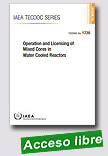 |
Operation and Licensing of Mixed Cores in Water Cooled Reactors
IAEA TECDOC, 2014, 90 p.
The performance and operation of mixed cores is of interest to many nuclear power plants as new and improved fuel designs have been introduced or a different fuel vendor has been chosen to supply fuel. Such decisions have generally been driven by economic considerations or by the expectation of improved fuel performance. The design and licensing of a fuel load in a reactor core are complex undertakings, even without
|
the additional complication of the usage of different fuel types. The issues that need to be considered include simple geometric compatibility of different fuel types, their different thermal-hydraulic characteristics and nuclear behaviour. This publication presents the outcome and the results of two meetings held on these topics and hosted by the IAEA. The meetings provided a forum to address the above mentioned issues and to review the accumulated experience and state of the art information on mixed core operation, as well as tools and techniques that are used to analyse the core operation and to demonstrate that there are no safety related issues.
Extraído de: http://www-pub.iaea.org/books/IAEABooks/10495/Operation-and-Licensing-of-Mixed-Cores-in-Water-Cooled-Reactor
|
 |
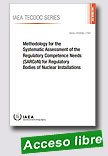 |
Methodology for the Systematic Assessment of the Regulatory Competence Needs (SARCoN) for Regulatory Bodies of Nuclear Installations
IAEA TECDOC 1757, 2015, 72 p.
This publication provides guidance for competence needs assessment (CNA) and offers a step by step approach to develop competence profiles for specific regulatory tasks. It explains how to analyse existing and required regulatory competences in order to identify gaps and thus training and competence needs. It also provides guidance on the
|
development and implementation of tools and programmes to address these gaps in conjunction with IAEA Safety Reports Series No. 79 on Managing Regulatory Body Competence.
Extraído de: http://www-pub.iaea.org/books/IAEABooks/10762/Methodology-for-the-Systematic-Assessment-of-the-Regulatory-Competence-Needs-SARCoN-for-Regulatory-Bodies-of-Nuclear-Installations
|
 |
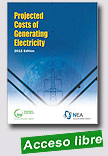 |
Projected Costs of Generating Electricity – 2015 Edition - Executive Summary
International Energy Agency (IEA) and the Nuclear Energy Agency (NEA), 2015, 11 p.
This joint report by the International Energy Agency (IEA) and the Nuclear Energy Agency (NEA) is the eighth in a series of studies on electricity generating costs. As policy makers work to ensure that the power supply is reliable, secure and affordable, while making it increasingly clean and sustainable in the context of the debate on climate change, it is becoming
|
more crucial that they understand what determines the relative cost of electricity generation using fossil fuel, nuclear or renewable sources of energy. A wide range of fuels and technologies are presented in the report, including natural gas, coal, nuclear, hydro, solar, onshore and offshore wind, biomass and biogas, geothermal, and combined heat and power, drawing on a database from surveys of investment and operating costs that include a larger number of countries than previous editions.
The analysis of more than 180 plants, based on data covering 22 countries, reveals several key trends, pointing, for example, to a significant decline in recent years in the cost of renewable generation. The report also reveals that nuclear energy costs remain in line with the cost of other baseload technologies, particularly in markets that value decarbonisation. Overall, cost drivers of the different generating technologies remain both market-specific and technology-specific.
Readers will find a wealth of details and analysis, supported by over 200 figures and tables, underlining this report's value as a tool for decision makers and researchers concerned with energy policies, climate change and the evolution of power sectors around the world.
Executive summary | Purchase the publication
Extraído de: http://www.oecd-nea.org/ndd/egc/2015
|
 |
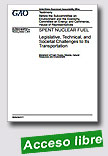 |
Spent nuclear fuel—the used fuel removed from commercial nuclear power reactors—is an extremely harmful substance if not managed properly. The nation's inventory of spent nuclear fuel has grown to about 72,000 metric tons currently stored at 75 sites in 33 states, primarily where it was generated.
Under the Nuclear Waste Policy Act of 1982, DOE was to investigate Yucca Mountain, a site about 100 miles northwest
|
of Las Vegas, Nevada, for the disposal of spent nuclear fuel. DOE terminated its work at Yucca Mountain in 2010 and now plans to transport the spent nuclear fuel to interim storage sites beginning in 2021 and 2024, then to a permanent disposal site by 2048. Transportation of spent nuclear fuel is a major element of any policy adopted to manage and dispose of spent nuclear fuel.
This testimony discusses three key challenges related to transporting spent nuclear fuel: legislative, technical, and societal. It is based on reports GAO issued from November 2009 to October 2014.
Highlights Page | Full Report
Extraído de: http://www.gao.gov/products/GAO-16-121T
|
 |
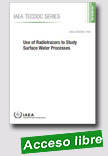 |
Use of Radiotracers to Study Surface Water Processes
IAEA TECDOC, 2015, 126 p.
Most of world´s population is directly affected by the available water resources and the means to supply them. All natural or anthropogenic processes that modify the water flux and quality have a direct impact on human lives. Radioactivity tracers can be extremely useful in studying such processes and thus help to investigate the common problems faced by many States and to find adequate solutions. Problems such as water pollution, erosion, river sedimentation, and the loss of storage capacity
|
of water reservoirs, thereby reducing fish stocks, can cause great damage and negatively affect the well-being of local populations.
To address this, a consultants meeting on the use of radioactive tracers to study surface water processes was organized by the IAEA to support Members States in situations where the use of radioactive tracers is considered as a major tool for a complete understanding of the process.
This publication represents a sound knowledge base for the conduct of radiotracer studies in the environment, with papers on radiotracer methodology, radiation protection and regulation, data analysis and modelling. Environmental case stories from five Members States - Australia, Brazil, France, the Republic of Korea and Sweden - provide information on conducting studies involving the use of radioactive tracers. These case histories are not meant as guidelines for preparing a field study but can rather serve as examples of the type, caution and extent of work involved in environmental studies using radiotracers.
This publication may provide guidance for conducting future training events in the use of radioactive tracers in the environment and can serve as a key reference to all concerned directly or indirectly with surface water processes.
Extraído de: http://www-pub.iaea.org/MTCD/Publications/PDF/TE-1760_web.pdf
|
 |
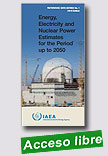
|
Energy, Electricity and Nuclear Power Estimates for the Period up to 2050 - 2015 Edition
IAEA Reference Data Series, 2015, 53 p.
The 35th edition of the annual Reference Data Series No.1 contains estimates of energy, electricity and nuclear power trends up to the year 2050, using a variety of sources, such as the IAEA’s Power Reactor Information System and data prepared by the United Nations. |
Extraído de:
http://www-pub.iaea.org/books/IAEABooks/10939/Energy-Electricity-and-Nuclear-Power-Estimates-for-the-Period-up-to-2050-2015-Edition
|
 |
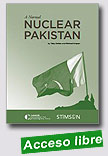 |
A Normal Nuclear Pakistan
Carnegie Endowment for International Peace, 2015, 48 p.
This report takes a hard look at Pakistan’s nuclear weaponrelated programs and its ambitions to be viewed as a normal state possessing advanced nuclear technologies. Pakistan’s military
leadership in Rawalpindi has several choices at this juncture. It can choose to accept success in achieving a “strategic” deterrent against India – a nuclear force posture sufficient to prevent limited nuclear exchanges and a major conventional
|
war. Alternatively, it can choose to continue to compete with India in the pursuit of “full spectrum” deterrence, which would entail open-ended nuclear requirements against targets both near and far from Pakistan.
These choices would lead Pakistan to two starkly different nuclear futures and places in the global nuclear order. The global nuclear order will not be strengthened by trying to accommodate a Pakistan that is greatly increasing its nuclear capabilities while rejecting the Comprehensive Test Ban Treaty and Fissile Material Cutoff Treaty. Nor will Pakistan become a normal, nuclear state by competing with India or by harboring groups that could spark a war with India. The international community is unlikely to accommodate Pakistan’s desire to enter the nuclear mainstream without corresponding steps by Pakistan to align aspects of its nuclear policy and practices closer with international norms. The steps we propose lend themselves to mainstreaming. More importantly, these steps would advance Pakistan’s national, social, and economic security interests.
Extraído de: http://carnegieendowment.org/files/NormalNuclearPakistan.pd
|
 |
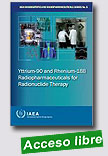 |
Yttrium-90 and Rhenium-188 Radiopharmaceuticals for Radionuclide Therapy
IAEA Radioisotopes and Radiopharmaceuticals Series, 2015, 301 p.
A key requirement for the effective implementation of the therapeutic approach, based on the intravenous administration of radiolabelled compounds (radionuclide therapy), is the sufficient availability of radionuclides with appropriate physical characteristics. Based on their nuclear properties, 188Re and 90Y are considered among the most interesting radionuclides
|
for therapy. Furthermore, they are produced through portable generators, which provide a crucial advantage toward ensuring a worldwide distribution of these radionuclides. This publication illustrates recent studies aimed at investigating efficient quality control methods to ensure both the radionuclidic purity of generator eluates, and the proper preparation of new target specific 188Re and 90Y radiopharmaceuticals for various clinical applications.
Extraído de: http://www-pub.iaea.org/books/IAEABooks/10560/Yttrium-90-and-Rhenium-188-Radiopharmaceuticals-for-Radionuclide-Therapy
|
 |
|
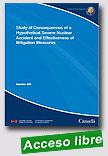
|
Study of Consequences of a Hypothetical Severe Nuclear Accident and Effectiveness of Mitigation Measures
Canadian Nuclear Safety Commission, September 2015, 139 p.
The Study of Consequences of a Hypothetical Severe Nuclear Accident and Effectiveness of Mitigation Measures was done to assess the consequences and possible preventative mitigation of a hypothetical severe nuclear accident in Canada. It addresses concerns raised during public hearings in December 2012 on the environmental assessment for the
|
Darlington Nuclear Generating Station refurbishment project.
In June 2014, the draft study was released for public consultation and presented to the Commission. Following the consultation period, the CNSC addressed and incorporated Commission feedback and comments from over 500 submissions from the public, government and other organizations. Certain study assumptions and language were clarified, and information was added on a number of topics such as reactor behaviour, emergency response decisions, risk acceptability, and comparisons to effects from the Fukushima accident. In some cases, dose and risk results were updated, using a statistical approach more consistent with how dose modelling would be done in an actual emergency. These changes did not alter the conclusions of the report.
A subsequent update was presented to the Commission in March 2015. The study was published on CNSC’s website in both languages in September 2015, in advance of Part 2 of the Darlington relicensing hearing being held in November 2015.
Some of the severe accident scenarios predicted doses that are comparable to the actual doses measured at Fukushima. The study concludes that, in the unlikely event of a radioactive release, there would be no detectable increased risk of cancer for most of the population, with the exception of an increase in childhood thyroid cancer risk. The result is not unexpected given the sensitivity of a child’s thyroid gland to radiation. The findings emphasize the continued importance of considering sensitive receptors (i.e., children) in emergency planning, such as KI pill administration.
Extraído de: http://www.nuclearsafety.gc.ca/eng/resources/health/hypothetical-severe-nuclear-accident-study.cfm
|
 |
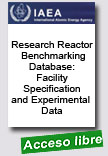 |
Research Reactor Benchmarking Database: Facility Specification and Experimental Data
IAEA Technical Reports Series, 2015, s. p.
This web publication contains the facility specifications, experiment descriptions, and corresponding experimental data for nine different research reactors covering a wide range of research reactor types, power levels and experimental configurations. Each data set was prepared in order to serve as a stand-alone resource of well documented experimental data, which can subsequently be used in benchmarking and .
|
validation of the neutronic and thermal-hydraulic computational methods and tools employed for improved utilization, operation and safety analysis of research reactors
Extraído de: http://www-pub.iaea.org/books/IAEABooks/10578/Research-Reactor-Benchmarking-Database-Facility-Specification-and-Experimental-Data
|
 |
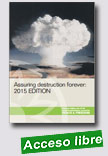 |
Assuring Destruction Forever: 2015 edition
Women's International League for Peace and Freedom (WILPF), April 2015, 100 p.
This updated study explores the ongoing and planned nuclear weapon modernization programmes in China, France, India, Israel, Pakistan, Russian Federation, the United Kingdom, and the United States.
As of April 2015, the nuclear-armed states are estimated to possess approximately 15,650 nuclear weapons. All of them have plans to modernise—upgrade and / or extend the lives |
|
 |
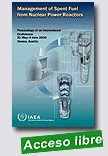 |
Management of Spent Fuel from Nuclear Power Reactors
IAEA Proceedings Series, 2015, 50 p.
This publication presents the proceedings of an international conference on spent fuel management organized by the IAEA in cooperation with the NEA of the OECD. The conference covered a broad range of topics from national strategies through safety and regulatory aspects, transport, technical innovation, fuel and material behaviour, operational experience
with storage, new fuel and reprocessing developments,
|
and long term storage and disposal. The conference also featured two round table discussion sessions covering regulatory frameworks and stakeholder issues. The proceedings include the opening presentations and the President’s summary and conclusions of the conference. A CD-ROM with contributed papers accompanies the publication.
Extraído de: http://www-pub.iaea.org/books/IAEABooks/10387/Management-of-Spent-Fuel-from-Nuclear-Power-Reactors-Proceedings-of-an-International-Conference-held-in-Vienna-Austria-31-May-4-June-2010
|
| |
| |
|
|
| |
|
|
|
|
|
